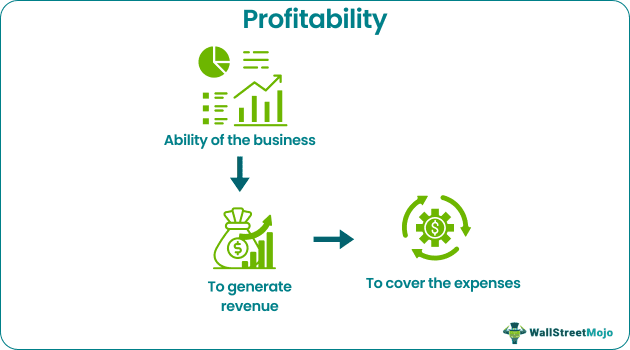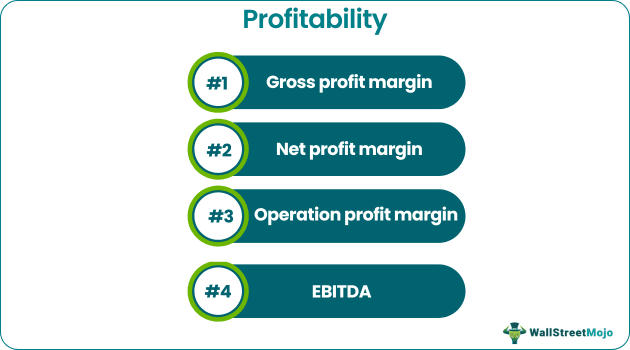Table Of Contents
Profitability Meaning
Profitability is the ability of a company or business to generate revenue over and above its expenses. It is usually measured using ratios like gross profit margin, net profit margin EBITDA, etc. These ratios help analysts, shareholders, and stakeholders to analyze and measure the company's ability to generate revenue.

The revenue earned is used to cover its operational cost, create value by adding assets to the balance sheet and analyze its ability to expand and take up projects for its future growth. The higher the ratio, the better it is because the company performs well. These ratios are often used to compare the performance of companies against each other.
Key Takeaways
- Profitability refers to a company's ability to generate revenue that exceeds its expenses. Ratios such as gross profit margin, net profit margin, and EBITDA are commonly used to assess profitability.
- Profitability analysis helps analysts, shareholders, and stakeholders evaluate the company's capacity to generate revenue and cover operational costs.
- By adding value to the balance sheet and demonstrating the ability to undertake growth projects, profitability contributes to business growth.
- Analysts employ these ratios to make informed investment decisions, while banks assess creditworthiness and grant loans based on profitability ratios.
Profitability Explained
The financial term profitability is used to explain the concept of profit earning capacity of a business. It is the ability or an organization, a project or an investment opportunity to generate good profit over a specific period of time. The net profitability not only help the business cover its cost and expenses, but also leave extra funds that can be used for meeting daily financial needs or reinvested to earn further returns.
It is a metric that is widely used to assess or evaluate the financial health of the entity and its probability of success and expansion in the future, It gives an idea to the stakeholders how much it can sustain and grow and also provide for any unforeseen situations, if they arise.
Business owners and investment analysts use profitability to determine whether it's wise to invest or not, considering its current and future growth. The business can sustain and meet the stakeholders’ demand only when it earns profit. However, it varies between business to business and between sectors.
Many external factors like market conditions, economic and political stability, consumer sentiments, etc., influence an organization's profits. Therefore, apart from generating profits, the company should concentrate on risk management to maintain its net profitability.
Formula
There are several formula or measures that are commonly used in the financial market to measure the business profitability. Let us go through them.
Gross Profit Margin – This can measure the percentage of revenue that is over and above the cost of goods sold (COGS). It is calculated by deducting the COGS from the revenue earned, and then the result is divided by the total revenue and multiplied by 100, to get the value as a percentage.
Gross Profit Margin = x100
Operating Profit Margin – This shows the percentage of revenue that is left after subtracting both COGS and operating expenses. It gives and understanding regarding the efficiency level of the business in running and managing the daily operations.
Operating Profit Margin = x100
Net Profit Margin = It represents the profit that is earned by the company after meeting all its expenses including interest and taxes. The formula is as follows:
Net Profit Margin = / Total Revenue] x100
Return On Equity (ROE) – This metric evaluates the profit earning capacity of an organization in relation to the shareholder’s equity. The formula for the same is given below:
ROE = (Net Income/ Shareholder’s equity) x 100
Return On Investment (ROI) – In this metric, the gain or loss of an investment is compared to the cost of the investment and evaluate the profit earning capacity of the business.
ROI = x 100
Example
Let us take an example of economic profitability.

- Sales = $50,000
- Purchase = $30,000
- Direct Costs = $500
- Rent = $1,000
- Salary = $3,000
- General Expenses = $1,500
- Depreciation = $500
- Interest Paid = $200
- Taxes @ 30% = $3,990
Profit = $ (50,000-30,000-500-1,000-3,000-1,500-500-200-3,990)
Profit = $9,310
Let us calculate the most commonly used ratios to calculate business profitability.
#1 - Gross Profit Margin
Gross profit margin is a ratio of gross profit to sales, which means the entity can recover its cost of production from the revenue it is earning. Therefore, the higher the percentage, the better it is.
As per the above example,
Calculation of gross profit will be: -

Gross Profit = Sales – Purchase – Direct Cost
Gross Profit = $(50,000-30,000-500)
Gross Profit = $19,500
Calculation of gross profit margin will be: -

Gross Profit Margin = Gross Profit / Sales
Gross Profit Margin = 19,500/50,000
Gross Profit Margin = 39%
#2 - Net Profit Margin
Net profit margin is a ratio of net profit to sales. Net profit is the profit earned after reducing operational costs, depreciation, and dividend from gross profit. A higher ratio/margin means the company is making well enough to cover all its costs and payout to its shareholders or reinvest its profit for growth.

Profitability = $9,310 / 50,000
Profitability = 18.62%.
As calculated above, the net profit margin is 18.62%.
#3 - Operation Profit Margin
Operating profit margin is a percentage of earnings to sales before interest expense and income taxes. A higher margin means companies are well equipped to pay for their fixed and operational costs. It also indicates efficient management and their ability to survive in economic downtime compared to their competitors.
As per the above example,
Calculation of operating profit will be: -

Operating Profit = Sales – Expenses excluding Interest and Taxes
Operating Profit = $(50,000-30,000-500-1,000-3,000-1,500-500)
Operating Profit = $13,500.
Calculation of operating profit margin will be: -

Operating Profit Margin = Operating Profit / Sales
Operating Profit Margin = 13,500/50,000
Operating Profit Margin =27%.
#4 - EBITDA
Its earnings before interest, tax, depreciation, and amortization. EBITDA is commonly used to compare a company's performance with others and is widely used in valuation and project financing.
As per the above example,
Calculation of EBITDA will be:-

EBITDA = Sales – Expenses (Excluding Interest, Tax, Depreciation, and Amortization)
EBITDA = $(50,000-30,000-500-1,000-3,000-1,500)
EBITDA = $14,000
Advantages
Some of the advantages are as follows: -
- Profitability helps us determine the pricing of our products and services. In many cases, if any revision is required. Pricing is very important for any business, as it leads to increases in net revenue. Still, it also has to be at a comparable level with competitors. Therefore, it helps in pricing strategy.
- Higher economic profitability is directly related to higher sales. The various ratios and metrics used help compare past data and analyze if the company can survive in a downtime.
- It helps us in analyzing the return on investment from a business. That means how effectively the company issues its resources to generate value and profit. In addition, it lets us know if the resources are properly deployed and if they can sustain in the future.
Disadvantages
Some of the disadvantages are as follows: -
- It does not accurately predict company performance in the future as companies often window dress their accounting statements.
- Cannot compare a company's performance across different industries. For example, the analysis of comparing pharmaceuticals with the FMCG industry would not be accurate.
Profitability ratios are key indicators to analyze the performance and liquidity of the company and are derived using income statements. It is also used to determine the strengths and weaknesses and how companies achieve profit from their operations. Analysts use ratios to decide whether or not it is a good proposal for investment purposes. Banking institutions often use such ratios to determine the creditworthiness of a company and sanction loans based on such ratios. Among other ratios, profitability ratios are of utmost importance as all businesses ultimately focus on earning profit and creating value for their stakeholders.
Profitability Vs Revenue
Both the above are important financial metric for assessing the financial condition of the entity. However, there are some differences between them, as follows:
- The profitability percentage measures the ability of the business to earn profit which is the earning left after covering the costs, whereas the latter is money that the business earns its primary business activity.
- The former is a broader assessment of the financial health of the company compared to the latter.
- The former is the measurement after deducting all expenses, taxes and interest payable, whereas the latter is the measurement which show the sales value of the organization.
- A company may have high revenue levels but of its expenses and costs are too high, then the profitability percentage will come down.
- Business sometimes focuses a lot on increasing the revenue levels at the cost of profits, which is harmful is the long run.
- The former shows how efficiently and smoothly the company is able to run its operations. However, the latter shows how efficiently the business is able to sell its products and services.
- The former gives an idea about the financial condition of the business and the latter gives an idea about the quality of its products, services, customer satisfaction, market share, etc.

